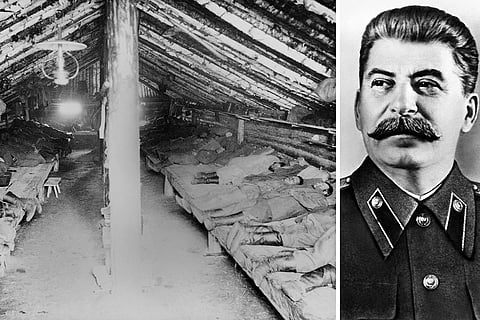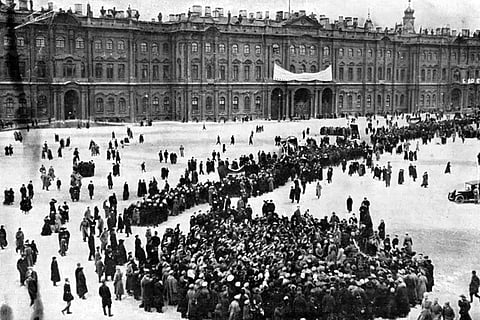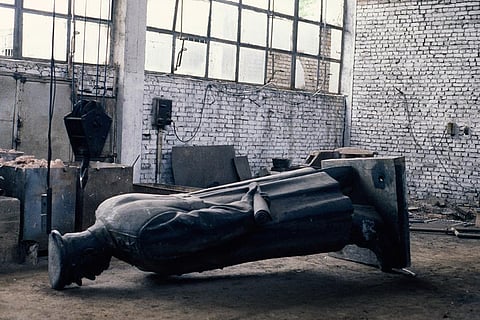A Red Yankee
The Word Rang Out: ‘Brothers!’
The source for alternative systems through Soviet reinventions, the Russian Revolution is now recalled with uneasy sufferance
- The Bolshevik Revolution is the subject of one of the great eyewitness accounts. John Reed’s Ten Days That Shook The World, introduced by Lenin and emblazoned with notices, speeches and the urgent heat of events, is a personal record and a historical document. It also helped create an enduring myth about 1917.
***
Of all the revolutions in world history, none reinvented itself as often, as successfully and with such global significance as the Russian Revolution. The English Revolution did not stretch beyond the Channel, except to the thin line of American colonies, spreading confusion through a scattered population from Maryland to Massachusetts. The American Revolution kept its libertarian urges locked in the Americas, with a minor extension to the Philippines in 1902, after running a full war with the ‘natives’. And it was only during the Cold War, over a century-and-a-half after that revolution, that ‘American democracy’ became ripe for export, a contemporary product that was distinct from the Jeffersonian and Jacksonian variety in language and institutions. The French Revolution, the only one that stands comparison with the Russian Revolution as a world event, after a brief reinvention in the Napoleonic dispensation, rapidly became the domain of local rituals, and evolved into an instructive memory, a revolutionary’s revolution, a figurative book of instructions about what could go right, and what could go wrong.
The Russian Revolution was reinvented thrice during the 20th century—using similar terms and language, claiming continuity with the events of October 1917, disassociating itself from the February Revolution of that year, except as backdrop. First came the socialist initiatives during the decade after the revolution, then the Stalinist recasting of those initiatives as a new path into an industrialised future, and finally socialist policy for the world during the Cold War. The year 1917 became indelibly marked as a socialist event in the personal and social memory of generations across the world, meaning different things to each, wedded together by symbols and imitations of common practice.
Yet, by the beginning of the 21st century, the Russian Revolution is apparently no more than a lodestone for a shrinking coterie of Communists or a field of academic study. Its lessons do not engage the intellect except in the most general terms. In its home territory, its anniversaries mark a time for observance for a declining Communist opposition; or for a look-back at a chapter of history—to be seen with other formative periods in Russia’s past—and perhaps evaluated as lacking in instructive value for the future.
The transformation has taken a little less than a quarter-century to happen. And it is explained glibly enough through allusion to the disintegration of the Soviet Union in 1991 and the decline in Communism the world over, i.e. through the disappearance or decay of the two cardinal ‘owners’ of the Russian Revolution and its legacy.

Sleeping quarters in a Siberian camp, and the man who sent millions there, Josef Stalin
This is a far from satisfactory situation in terms of depiction of global awareness, the explanation begging the question, if nothing else. And the fact that it is unsatisfactory is testified to by the unease with which ‘remembering’ the revolution is greeted. There is no straightforward acceptance that a chapter is closed: that a trajectory has run its course and that a history has ended; although all this is hinted ubiquitously. In Russia itself, the presidency has grudgingly taken on the task—a little late, in December 2016—of memorialising the revolution. But this has been followed by inaction over the next eight months. In China, in the PRC, little is said, but there are Communist tours being prepared for St Petersburg and Moscow for November; while in India, what is to be said in appropriate circles has still to be said. All round, in the public domain the revolution provokes a mixed response and a paralysis of engagement. Hapless academics record what has occurred in a three-volume History of Communism that leaves no clear perspective overall, but a determination to have one. How the revolution and its consequences are to be evaluated, beyond pronouncements that call to the faithful, remains resoundingly unclear.
The situation calls for introspection and speculation. And an explanation more appropriate to the current lack of focus than absence of patronage or exhaustion of ideology is not difficult to find. Arguably, inability to establish orientation in a post-revolutionary or counter-revolutionary present is the product of unease about establishing distance from the revolution’s agenda: the deep sense that much about that agenda remains valid, and that the processes set in motion to achieve goals were partly successful. Many of the issues touched by the revolution during each reinvention remain challenges on a global scale at the beginning of the 21st century—social inequality, as Thomas Piketty has shown graphically, being in the lead, and global inequality equally so.
But, in fair measure, sympathy for the revolution means sympathy for its sins—overwhelming at the centre, significant at the periphery. To articulate such sympathy, especially in core territories, is unseemly and unacceptable.
Here, it remains ‘memorable’ that the Russian Revolution engaged with political enfranchise ment, creating the most egalitarian republic in the world under the ‘February’ and ‘October’ revolutions. After October, the revolutionary establishment generated a powerful critique of parliamentary democracy—already the focus of diatribe by figures such Pareto, Mosca and Michels after Marx and Weber—as it created Soviet democratic practice. Thereafter, taking as reference the October Revolution, the Soviet state followed with policy to counter economic inequality in town and country, industry and agriculture. War Communism provided a sense of order to this, making allowances for its limitations in the New Economic Policy. The USSR placed its endeavours in the framework of a bowdlerised Marxist reading of history that endowed it with the images of modernity and progress. The dispensation centred on public ownership (‘state capitalism’) and was exclusivist in its egalitarianism—excluding the former elite, propertied classes and antagonists of Bolshevism.
Such exclusion, together with the harsh conditions of the Civil War of 1919-21, would mark a generation. Millions passed into exile. The ‘autocracy’ of Bolshevism would not be forgotten, nor the excesses of the first Soviet secret police, the Cheka. Memories would be preserved in the annals of the diaspora and relayed through publishing houses like the YMCA Press in Paris. That diaspora found its patrons through Europe and the United States, ensuring its afterlife in the world of images and books. Nationalists such as the Bashkir scholar-revolutionary Zeki Velidi Togan, whose cause had been hijacked by Bolshevism, found sanctuary and pulpit in Turkey.
But in the Soviet Union, a reinvention of the significance of the October Revolution came under Stalin in the 1930s, with the Planned Economy carrying forward egalitarianism into industrial and agricultural progress based on public ownership. Production centres at new steel towns stood in stark contrast with the Depression in the West at the time; and outcomes withstood the onslaught of German armies in 1941-45.
Felt rather than articulated with clarity, the decades also saw the disastrous consequences of the collectivisation of agriculture (1929-33), which Nikita Khruschev would later describe as near civil war. This and Stalin’s tensions with many in the Communist Party generated the purges, arrests and the hasty justice of ‘dvoikas’ and ‘troikas’ (tribunals of two and three) of the secret police that often demanded the ‘highest measure of punishment’ (i.e. death). In two years alone, in 1937-38, in the cold statistics of Soviet officials, 7,00,000 executions took place within the framework of the state corrective camp system (GULAG). Later, despite the heroism of the war, the deep incursion of German troops into Ukraine and southern Russia led to suspicion of collaboration and permanent exile for a series of ethnic communities (Kalymyks, Volga Germans, Crimean Tatars, Chechens).

October 25, 1917 Bolsheviks storm the Winter Palace in St Petersburg and seize power
In the 1950s, a fresh reinvention came with the Soviet model for export during the Cold War. Such ‘export’ to Africa, the Middle East, South and Southeast Asia indicated a crucial ‘add-on’ to the legacy of the revolution. This was its presence as a corollary to national liberation globally—a path taken from the time of the formation of the Comintern in 1919. The revolution was now profiled as the source of a global force standing for economic as well as political equality. Two phenomena became connected by a thin but substantial umbilical cord—a putative emerging global socialist order and the cause of post-colonial nationalism. From the steel factories at Bhilai in the ’50s to Castro’s Cuba and diamond collaboration and infrastructural projects in Neto’s Angola and Mengistu’s Ethiopia in the ’70s, the reworked standard of the revolution commanded respect.
The profile in Eastern Europe and in the USSR was more chequered. The Slansky trials, the brutalities in Hungary and the frequent use of the secret police created resentment against a background of growth. The refusal to redress the dark side of Stalinism under a tight-lipped Brezhnev bureaucracy affected the credibility of the party in the USSR. As new questions were asked for new times—for instance, on the environment and education—censorship and red tape stymied invention.
The guardians of the Revolution became unimaginative technocrats. The leaders of the largest country on Earth restated axioms of the revolution without thought to the point of tedium—elaborating their implications in a stilted and bureaucratic manner.
Much of this was sought to be set right in the reinvention of the revolution through M.S. Gorbachev’s perestroika—which continued to hold the revolution as its standard at the 70th anniversary in 1987. But it was reinvention that was to be thwarted by internal dissension and bureaucratic temper in the Soviet Communist Party. Also, the departure lacked difference to the contemporary eye. Acceptance in the eyes of arch conservative Thatchers and Reagans destroyed the image of the revolution as challenge.

A Stalin statue meets its undignified fate in Tirana, Albania in 1992
Hence, during the memorable conjuncture of 1989-91, on the one hand, for 70 years and more, October 1917 stood out as the centre of the Russian Revolution, as an example of a path towards modernity sharply at variance with ‘capitalist’ and ‘imperialist’ paradigms, acting as pivot to global alternatives for a host of countries in Latin America, Africa and Asia. But the direction of its new votaries was unclear. Victims of ‘reinventions’ gone by in Russia and elsewhere found common cause in 1991, just as their equivalents in Eastern Europe had done in 1989, when the Berlin Wall had fallen. In Russia they were a cohort that came forward and refused to leave centrestage thereafter.
What is left, though, remains remarkable. The appropriate list includes Communist parties or their equivalents in a host of countries (constituting ‘the Left’ of the EU parliament for instance), including the former Soviet Union. Also to be counted are clear histories of the challenge to a prevalent world order through the 20th century. The legacy of the revolution, impossible to integrate in the manner of the past, is not without admirers and votaries, moved more by distant image than real acquaintance. Such history, unlike the rhetorical output of Anna Applebaum on the Cold War or the Gulag, is comprehensive evaluation, as at the Museum of Political History in St Petersburg.
The phenomenon of reinvention and memorialisation is a thing of the past and the solid presence of ‘October 1917’ in the world through festivities, banners and fanfare is reduced. The 25 years since Soviet disintegration and capitalist ascendancy the world over have obliterated continuities with October 1917, whatever its reinventions. Yet more subtle memories of outcomes remain in a global scenario where solid history of past achievements, warts and all, point to past solutions: memories reinforced by the experiences of generations still alive.
On November 7, consequently, on the centenary of the October uprising, there will be no red festoons at Red Square in Moscow: no phalanx of apparatchiks at a podium articulating homilies repeated in Pravda and Izvestia for national and global circulation. There will be no snide comments of dissidents and ex-exiles watching thin lines of marchers moving to make a manageable crowd, according to a script ordered by the Communist Party. But there will be heroic stories the world over that attract the curiosity of those beaten by the sins of capitalism under globalisation.
The Revolution as a perennial global presence may be over. But it is not clear that either its legacies, or the power of its images, are to be written off.
Hari Vasudevan is UGC Professor Emeritus, Department of History, Calcutta University